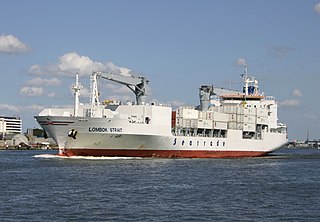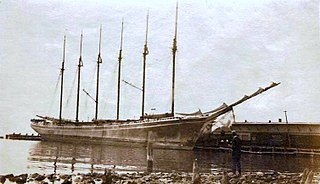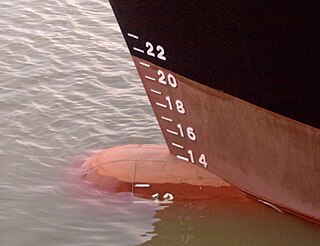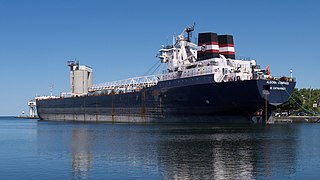Related Research Articles

Ton is the name of any one of several units of measure. It has a long history and has acquired several meanings and uses.
Tonnage is a measure of the cargo-carrying capacity of a ship, and is commonly used to assess fees on commercial shipping. The term derives from the taxation paid on tuns or casks of wine. In modern maritime usage, "tonnage" specifically refers to a calculation of the volume or cargo volume of a ship. Although tonnage (volume) should not be confused with displacement, the long ton of 2,240 lb is derived from the fact that a "tun" of wine typically weighed that much.
The long ton, also known as the imperial ton or displacement ton, is the name for the unit called the "ton" in the avoirdupois system of weights or Imperial system of measurements. It was standardised in the 13th century. It is used in the United Kingdom and several other Commonwealth of Nations countries alongside the mass-based tonne defined in 1799, as well as in the United States for bulk commodities.

A passenger ship is a merchant ship whose primary function is to carry passengers on the sea. The category does not include cargo vessels which have accommodations for limited numbers of passengers, such as the ubiquitous twelve-passenger freighters once common on the seas in which the transport of passengers is secondary to the carriage of freight. The type does however include many classes of ships designed to transport substantial numbers of passengers as well as freight. Indeed, until recently virtually all ocean liners were able to transport mail, package freight and express, and other cargo in addition to passenger luggage, and were equipped with cargo holds and derricks, kingposts, or other cargo-handling gear for that purpose. Only in more recent ocean liners and in virtually all cruise ships has this cargo capacity been eliminated.

The twenty-foot equivalent unit is an inexact unit of cargo capacity, often used for container ships and container ports. It is based on the volume of a 20-foot-long (6.1 m) intermodal container, a standard-sized metal box which can be easily transferred between different modes of transportation, such as ships, trains, and trucks.

A reefer ship is a refrigerated cargo ship typically used to transport perishable cargo, which require temperature-controlled handling, such as fruits, meat, vegetables, dairy products, and similar items.

A turret deck ship is a type of merchant ship with an unusual hull, designed and built in the late 19th and early 20th centuries. The hulls of turret deck vessels were rounded and stepped inward above their waterlines. This gave some advantages in strength and allowed them to pay lower canal tolls under tonnage measurement rules then in effect. The type ceased to be built after those rules changed. The last turret deck ship in existence was scrapped in 1960.
Gross register tonnage or gross registered tonnage, is a ship's total internal volume expressed in "register tons", each of which is equal to 100 cubic feet (2.83 m3). Replaced by Gross Tonnage (GT), gross register tonnage uses the total permanently enclosed capacity of the vessel as its basis for volume. Typically this is used for dockage fees, canal transit fees, and similar purposes where it is appropriate to charge based on the size of the entire vessel. Internationally, GRT may be abbreviated as BRT for the German "Bruttoregistertonne".

Gross tonnage is a nonlinear measure of a ship's overall internal volume. Gross tonnage is different from gross register tonnage. Neither gross tonnage nor gross register tonnage should be confused with measures of mass or weight such as deadweight tonnage or displacement.
Nippon Kaiji Kyokai is a ship classification society.

Wyoming was an American wooden six-masted schooner built and completed in 1909 by the firm of Percy & Small in Bath, Maine. With a length of 450 ft (140 m) from jib-boom tip to spanker boom tip, Wyoming was the largest known wooden ship ever built.
Builder's Old Measurement is the method used in England from approximately 1650 to 1849 for calculating the cargo capacity of a ship. It is a volumetric measurement of cubic capacity. It estimated the tonnage of a ship based on length and maximum beam. It is expressed in "tons burden", and abbreviated "tons bm".

The displacement or displacement tonnage of a ship is its weight. As the term indicates, it is measured indirectly, using Archimedes' principle, by first calculating the volume of water displaced by the ship, then converting that value into weight. Traditionally, various measurement rules have been in use, giving various measures in long tons. Today, tonnes are more commonly used.

Net tonnage is a dimensionless index calculated from the total moulded volume of the ship's cargo spaces by using a mathematical formula. Defined in The International Convention on Tonnage Measurement of Ships that was adopted by the International Maritime Organization in 1969, the net tonnage replaced the earlier net register tonnage (NRT) which denoted the volume of the ship's revenue-earning spaces in "register tons", units of volume equal to 100 cubic feet (2.83 m3). Net tonnage is used to calculate the port duties and should not be taken as less than 30 per cent of the ship's gross tonnage.
Net register tonnage is a ship's cargo volume capacity expressed in "register tons", one of which equals to a volume of 100 cubic feet (2.83 m3). It is calculated by subtracting non-revenue-earning spaces i.e. spaces not available for carrying cargo, for example engine rooms, fuel tanks and crew quarters, from the ship's gross register tonnage. Net tonnage is thus used in situations where a vessel's earning capacity is important, rather than its mere size. Net register tonnage is not a measure of the weight of the ship or its cargo, and should not be confused with terms such as deadweight tonnage or displacement.

SS Washingtonian was a cargo ship launched in 1913 by the Maryland Steel Company of Sparrows Point, Maryland, near Baltimore, as one of eight sister ships for the American-Hawaiian Steamship Company. At the time of her launch, she was the largest cargo ship under American registry. During the United States occupation of Veracruz in April 1914, Washingtonian was chartered by the United States Department of the Navy for service as a non-commissioned refrigerated supply ship for the U.S. fleet stationed off the Mexican coast.
Ship measurements consist of a multitude of terms and definitions specifically related to ships and measuring or defining their characteristics.

Algoma Compass, formerly Roger M. Kyes and Adam E. Cornelius, is a self-unloading bulk carrier built in Toledo, Ohio in 1973 for the American Steamship Company. The bulk carrier carried bulk cargoes throughout the Great Lakes and St. Lawrence Seaway. The vessel has earned a reputation as a "hard luck" ship, experiencing mechanical failures and groundings. In 2018, the ship was acquired by Algoma Central and put in service as Algoma Compass.

The Trillium class is a series of freighters owned by Canada Steamship Lines (CSL). The class is divided into three subclasses; the self-discharging lake freighters, the lake bulk carriers, and the Panamax self-discharging bulk carriers. Initially a nine-ship building program, six are operated by Canada Steamship Lines for use on the Great Lakes, while three are operated by CSL Americas for international trade. Two more ships were acquired later for use by CSL Americas.

Rio de la Plata is a container ship owned by A.P. Moller Singapore Pte. Ltd. and operated by Maersk Line AS. The 286.45-metre (939.8 ft) long ship was built at Daewoo Shipbuilding & Marine Engineering in Okpo, South Korea in 2008. Originally owned by Rio de Janeiro GmbH & Co KG, a subsidiary of Hamburg Süd, she has had two owners and been registered under two flags.
References
- ↑ Essex, Phil; Mork, Craig S.; Pomeroy, Craig A. "Owner's Guide to Tonnage Measurement 1998-2003" (PDF). Jensen Maritime Consultants, Inc. Retrieved 2007-04-27.
- ↑ Kemp, P., ed. (1976). The Oxford Companion to Ships & the Sea . Oxford University Press. ISBN 0-19-211553-7.